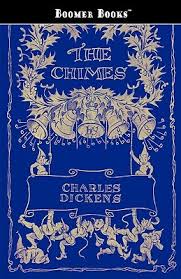Dickens’s Other Christmas Carols
Listen to the Recess! Clip
| Author | Rita Smith |
| Air Date | 12/24/2001 |

Dickens’s Other Christmas Carols Transcript
Charles Dickens is intimately associated with our ideas of Christmas through his novels and through a series of books which have become known as the Christmas Books. The first of them, the familiar A Christmas Carol, was written during 1843. It appeared in print that Christmas and was so successful that he followed it up the next Christmas with The Chimes, a Goblin Story. In 1845 came The Cricket on the Hearth, A Fairy Tale of Home, followed by two more, The Battle of Life in 1846 and The Haunted Man in 1848.1
A Christmas Carol sets the tone for all the others. The descriptive passages are filled with animism which one often finds in storybooks: an ancient church tower strikes the hours “as if its teeth were chattering in its frozen head;” the fire-plug is “left in solitude, its overflowings sullenly congealed, and turned to misanthropic ice;” and the shops “have great round pot-bellied baskets of chestnuts, shaped like the waist-coats of jolly old gentlemen, lolling at the doors, and tumbling out into the street in their apoplectic opulence.” Each of the books contains similar passages and each of them, one critic points out, “with the exception of The Battle of Life, is basically the same story: a wretched mortal changes the course of his life through a divine intermediary. It matters little whether it is Marley’s Ghost in a Christmas Carol, the Goblins of the Bell in The Chimes, the Genius of the Hearth and Home in The Cricket on the Hearth, or the Phantom in The Haunted Man. It might as well be Cinderella’s fairy godmother.”2
Readers of Dickens’s Christmas books, whether children or adults, are entertained by his ghosts and goblins and by the descriptions of the jollities and feasts of the traditional Christmas, but they also realize that, behind the ghosts, the noise and celebrations, lies a more serious thought; that the spirit of Christmas also includes giving to the world more than one takes from it, living as unselfishly as possible, and devoting oneself to others.3
One writer suggests, that if “during the Christmas festivities, one wishes to escape for a brief spell from the all-pervading spirit of carnival which sometimes does seem entirely alien to the true spirit of Christmas, let one seek a favourite arm-chair, and safely ensconced therein, spend a quiet hour with Dickens; for is he not pre-eminently the arch-priest of the festival, the author best suited to be ones companion by the Christmas fireside.”4
1 Oxford, p. 116.
2 Hearn, p. 183.
3 Brereton, p. xvi.
4 Ibid, p. xiii.
Sources:
Brereton, D.N. “Introduction,” in Dickens, Charles, Christmas Books. London and Glasgow: Collins Clear-Type Press, [1907]
Carpenter, Humphrey and Mari Prichard, The Oxford Companion to Children’s Literature. Oxford and New York: Oxford University Press, 1984.
Hearn, Michael Patrick, “Charles Dickens 1812-1870,” in Writers for Children: Critical Studies of Major Authors Since the Seventeenth Century, Jane M. Bingham, ed. New York: Scribners, 1988.